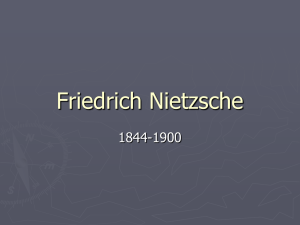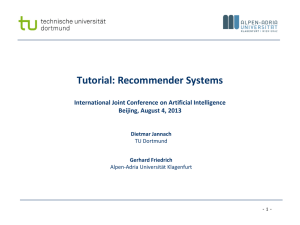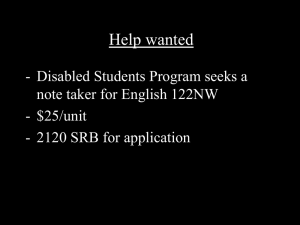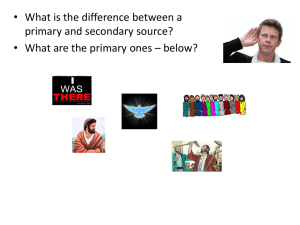Dietmar Jannach - Recommender Systems
advertisement
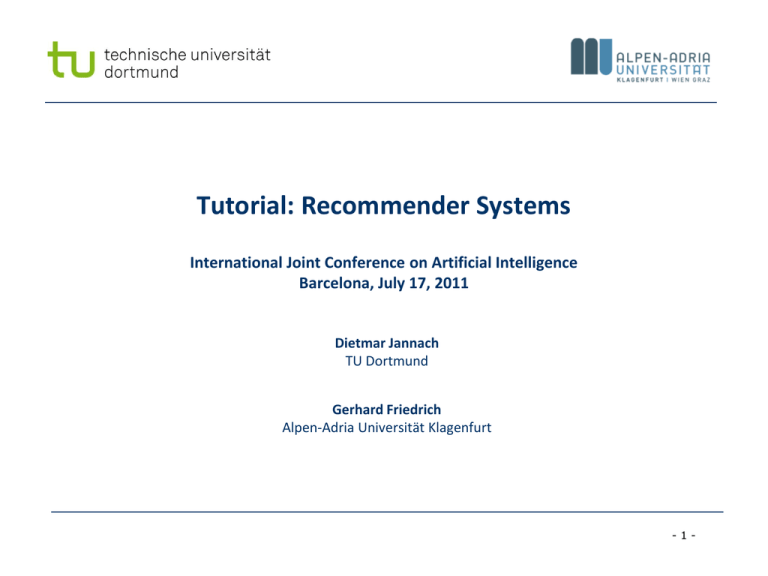
Tutorial: Recommender Systems
International Joint Conference on Artificial Intelligence
Barcelona, July 17, 2011
Dietmar Jannach
TU Dortmund
Gerhard Friedrich
Alpen-Adria Universität Klagenfurt
-1-
© Dietmar Jannach, Markus Zanker and Gerhard Friedrich
-2-
About the speakers
Gerhard Friedrich
– Professor at University Klagenfurt
Dietmar Jannach
– Professor at TU Dortmund, Germany
Research background and interests
– Application of Intelligent Systems technology in business
Recommender systems implementation & evaluation
Product configuration systems
Web mining
Operations research
© Dietmar Jannach, Markus Zanker and Gerhard Friedrich
-3-
Agenda
What are recommender systems for?
– Introduction
How do they work (Part I) ?
– Collaborative Filtering
How to measure their success?
– Evaluation techniques
How do they work (Part II) ?
– Content-based Filtering
– Knowledge-Based Recommendations
– Hybridization Strategies
Advanced topics
– Explanations
– Human decision making
© Dietmar Jannach, Markus Zanker and Gerhard Friedrich
-4-
© Dietmar Jannach, Markus Zanker and Gerhard Friedrich
-5-
Problem domain
Recommendation systems (RS) help to match users with items
– Ease information overload
– Sales assistance (guidance, advisory, persuasion,…)
RS are software agents that elicit the interests and preferences of individual
consumers […] and make recommendations accordingly.
They have the potential to support and improve the quality of the
decisions consumers make while searching for and selecting products online.
» [Xiao & Benbasat, MISQ, 2007]
Different system designs / paradigms
– Based on availability of exploitable data
– Implicit and explicit user feedback
– Domain characteristics
© Dietmar Jannach, Markus Zanker and Gerhard Friedrich
-6-
Purpose and success criteria (1)
Different perspectives/aspects
–
–
Retrieval perspective
–
–
–
Depends on domain and purpose
No holistic evaluation scenario exists
Reduce search costs
Provide "correct" proposals
Users know in advance what they want
Recommendation perspective
–
–
Serendipity – identify items from the Long Tail
Users did not know about existence
© Dietmar Jannach, Markus Zanker and Gerhard Friedrich
-7-
When does a RS do its job well?
Recommend items
from the long tail
© Dietmar Jannach, Markus Zanker and Gerhard Friedrich
"Recommend widely
unknown items that
users might actually
like!"
20% of items
accumulate 74% of all
positive ratings
Items rated > 3 in
MovieLens 100K
dataset
-8-
Purpose and success criteria (2)
Prediction perspective
–
–
Interaction perspective
–
–
–
Predict to what degree users like an item
Most popular evaluation scenario in research
Give users a "good feeling"
Educate users about the product domain
Convince/persuade users - explain
Finally, conversion perspective
–
–
–
Commercial situations
Increase "hit", "clickthrough", "lookers to bookers" rates
Optimize sales margins and profit
© Dietmar Jannach, Markus Zanker and Gerhard Friedrich
-9-
Recommender systems
RS seen as a function [AT05]
Given:
– User model (e.g. ratings, preferences, demographics, situational context)
– Items (with or without description of item characteristics)
Find:
– Relevance score. Used for ranking.
Relation to Information Retrieval:
– IR is finding material [..] of an unstructured nature [..] that satisfies an
information need from within large collections [..].
» [Manning et al., CUP, 2008]
© Dietmar Jannach, Markus Zanker and Gerhard Friedrich
- 10 -
Paradigms of recommender systems
Recommender systems reduce
information overload by estimating
relevance
© Dietmar Jannach, Markus Zanker and Gerhard Friedrich
- 11 -
Paradigms of recommender systems
Personalized recommendations
© Dietmar Jannach, Markus Zanker and Gerhard Friedrich
- 12 -
Paradigms of recommender systems
Collaborative: "Tell me what's popular
among my peers"
© Dietmar Jannach, Markus Zanker and Gerhard Friedrich
- 13 -
Paradigms of recommender systems
Content-based: "Show me more of the
same what I've liked"
© Dietmar Jannach, Markus Zanker and Gerhard Friedrich
- 14 -
Paradigms of recommender systems
Knowledge-based: "Tell me what fits
based on my needs"
© Dietmar Jannach, Markus Zanker and Gerhard Friedrich
- 15 -
Paradigms of recommender systems
Hybrid: combinations of various inputs
and/or composition of different
mechanism
© Dietmar Jannach, Markus Zanker and Gerhard Friedrich
- 16 -
Recommender systems: basic techniques
Pros
Cons
Collaborative
Nearly no ramp-up effort,
serendipity of results,
learns market segments
Requires some form of rating
feedback, cold start for new users
and new items
Content-based
No community required,
comparison between
items possible
Content-descriptions necessary,
cold start for new users, no
surprises
Knowledge-based
Deterministic
recommendations,
assured quality, no coldstart, can resemble sales
dialogue
Knowledge engineering effort to
bootstrap, basically static, does
not react to short-term trends
- 17 -
© Dietmar Jannach, Markus Zanker and Gerhard Friedrich
- 18 -
Collaborative Filtering (CF)
The most prominent approach to generate recommendations
– used by large, commercial e-commerce sites
– well-understood, various algorithms and variations exist
– applicable in many domains (book, movies, DVDs, ..)
Approach
– use the "wisdom of the crowd" to recommend items
Basic assumption and idea
– Users give ratings to catalog items (implicitly or explicitly)
– Customers who had similar tastes in the past, will have similar tastes in the
future
© Dietmar Jannach, Markus Zanker and Gerhard Friedrich
- 19 -
1992: Using collaborative filtering to weave an information
tapestry, D. Goldberg et al., Communications of the ACM
Basic idea: "Eager readers read all docs immediately, casual readers wait
for the eager readers to annotate"
Experimental mail system at Xerox Parc that records reactions of users
when reading a mail
Users are provided with personalized mailing list filters instead of being
forced to subscribe
– Content-based filters (topics, from/to/subject…)
– Collaborative filters
E.g. Mails to [all] which were replied by [John Doe] and which received
positive ratings from [X] and [Y].
© Dietmar Jannach, Markus Zanker and Gerhard Friedrich
- 20 -
1994: GroupLens: an open architecture for collaborative filtering of
netnews, P. Resnick et al., ACM CSCW
Tapestry system does not aggregate ratings and requires knowing each
other
Basic idea: "People who agreed in their subjective evaluations in the
past are likely to agree again in the future"
Builds on newsgroup browsers with rating functionality
© Dietmar Jannach, Markus Zanker and Gerhard Friedrich
- 21 -
User-based nearest-neighbor collaborative filtering (1)
The basic technique:
– Given an "active user" (Alice) and an item I not yet seen by Alice
– The goal is to estimate Alice's rating for this item, e.g., by
find a set of users (peers) who liked the same items as Alice in the past and
who have rated item I
use, e.g. the average of their ratings to predict, if Alice will like item I
do this for all items Alice has not seen and recommend the best-rated
Item1
Item2
Item3
Item4
Item5
Alice
5
3
4
4
?
User1
3
1
2
3
3
User2
4
3
4
3
5
User3
3
3
1
5
4
User4
1
5
5
2
1
© Dietmar Jannach, Markus Zanker and Gerhard Friedrich
- 22 -
User-based nearest-neighbor collaborative filtering (2)
Some first questions
– How do we measure similarity?
– How many neighbors should we consider?
– How do we generate a prediction from the neighbors' ratings?
Item1
Item2
Item3
Item4
Item5
Alice
5
3
4
4
?
User1
3
1
2
3
3
User2
4
3
4
3
5
User3
3
3
1
5
4
User4
1
5
5
2
1
© Dietmar Jannach, Markus Zanker and Gerhard Friedrich
- 23 -
Measuring user similarity
A popular similarity measure in user-based CF: Pearson correlation
a, b : users
ra,p : rating of user a for item p
P : set of items, rated both by a and b
Possible similarity values between -1 and 1; 𝒓𝒂 , 𝒓𝒃 = user's average ratings
Item1
Item2
Item3
Item4
Item5
Alice
5
3
4
4
?
User1
3
1
2
3
3
User2
4
3
4
3
5
User3
3
3
1
5
4
User4
1
5
5
2
1
© Dietmar Jannach, Markus Zanker and Gerhard Friedrich
sim = 0,85
sim = 0,70
sim = -0,79
- 24 -
Pearson correlation
Takes differences in rating behavior into account
6
Alice
5
User1
User4
4
Ratings
3
2
1
0
Item1
Item2
Item3
Item4
Works well in usual domains, compared with alternative measures
– such as cosine similarity
© Dietmar Jannach, Markus Zanker and Gerhard Friedrich
- 25 -
Making predictions
A common prediction function:
Calculate, whether the neighbors' ratings for the unseen item i are higher
or lower than their average
Combine the rating differences – use the similarity with as a weight
Add/subtract the neighbors' bias from the active user's average and use
this as a prediction
© Dietmar Jannach, Markus Zanker and Gerhard Friedrich
- 26 -
Improving the metrics / prediction function
Not all neighbor ratings might be equally "valuable"
– Agreement on commonly liked items is not so informative as agreement on
controversial items
– Possible solution: Give more weight to items that have a higher variance
Value of number of co-rated items
– Use "significance weighting", by e.g., linearly reducing the weight when the
number of co-rated items is low
Case amplification
– Intuition: Give more weight to "very similar" neighbors, i.e., where the
similarity value is close to 1.
Neighborhood selection
– Use similarity threshold or fixed number of neighbors
© Dietmar Jannach, Markus Zanker and Gerhard Friedrich
- 27 -
Memory-based and model-based approaches
User-based CF is said to be "memory-based"
– the rating matrix is directly used to find neighbors / make predictions
– does not scale for most real-world scenarios
– large e-commerce sites have tens of millions of customers and millions of
items
Model-based approaches
–
–
–
–
–
based on an offline pre-processing or "model-learning" phase
at run-time, only the learned model is used to make predictions
models are updated / re-trained periodically
large variety of techniques used
model-building and updating can be computationally expensive
© Dietmar Jannach, Markus Zanker and Gerhard Friedrich
- 28 -
2001: Item-based collaborative filtering recommendation algorithms, B.
Sarwar et al., WWW 2001
Scalability issues arise with U2U if many more users than items
(m >> n , m = |users|, n = |items|)
– e.g. amazon.com
– Space complexity O(m2) when pre-computed
– Time complexity for computing Pearson O(m2n)
High sparsity leads to few common ratings between two users
Basic idea: "Item-based CF exploits relationships between items first,
instead of relationships between users"
© Dietmar Jannach, Markus Zanker and Gerhard Friedrich
- 29 -
Item-based collaborative filtering
Basic idea:
– Use the similarity between items (and not users) to make predictions
Example:
– Look for items that are similar to Item5
– Take Alice's ratings for these items to predict the rating for Item5
Item1
Item2
Item3
Item4
Item5
Alice
5
3
4
4
?
User1
3
1
2
3
3
User2
4
3
4
3
5
User3
3
3
1
5
4
User4
1
5
5
2
1
© Dietmar Jannach, Markus Zanker and Gerhard Friedrich
- 30 -
The cosine similarity measure
Produces better results in item-to-item filtering
– for some datasets, no consistent picture in literature
Ratings are seen as vector in n-dimensional space
Similarity is calculated based on the angle between the vectors
Adjusted cosine similarity
– take average user ratings into account, transform the original ratings
– U: set of users who have rated both items a and b
© Dietmar Jannach, Markus Zanker and Gerhard Friedrich
- 31 -
Pre-processing for item-based filtering
Item-based filtering does not solve the scalability problem itself
Pre-processing approach by Amazon.com (in 2003)
– Calculate all pair-wise item similarities in advance
– The neighborhood to be used at run-time is typically rather small, because
only items are taken into account which the user has rated
– Item similarities are supposed to be more stable than user similarities
Memory requirements
– Up to N2 pair-wise similarities to be memorized (N = number of items) in
theory
– In practice, this is significantly lower (items with no co-ratings)
– Further reductions possible
Minimum threshold for co-ratings (items, which are rated at least by n users)
Limit the size of the neighborhood (might affect recommendation accuracy)
© Dietmar Jannach, Markus Zanker and Gerhard Friedrich
- 32 -
More on ratings
Pure CF-based systems only rely on the rating matrix
Explicit ratings
– Most commonly used (1 to 5, 1 to 7 Likert response scales)
– Research topics
"Optimal" granularity of scale; indication that 10-point scale is better accepted in
movie domain
Multidimensional ratings (multiple ratings per movie)
– Challenge
Users not always willing to rate many items; sparse rating matrices
How to stimulate users to rate more items?
Implicit ratings
– clicks, page views, time spent on some page, demo downloads …
– Can be used in addition to explicit ones; question of correctness of interpretation
© Dietmar Jannach, Markus Zanker and Gerhard Friedrich
- 33 -
Data sparsity problems
Cold start problem
– How to recommend new items? What to recommend to new users?
Straightforward approaches
– Ask/force users to rate a set of items
– Use another method (e.g., content-based, demographic or simply nonpersonalized) in the initial phase
Alternatives
– Use better algorithms (beyond nearest-neighbor approaches)
– Example:
In nearest-neighbor approaches, the set of sufficiently similar neighbors might
be to small to make good predictions
Assume "transitivity" of neighborhoods
© Dietmar Jannach, Markus Zanker and Gerhard Friedrich
- 34 -
Example algorithms for sparse datasets
Recursive CF
– Assume there is a very close neighbor n of u who however has not rated the
target item i yet.
– Idea:
Apply CF-method recursively and predict a rating for item i for the neighbor
Use this predicted rating instead of the rating of a more distant direct
neighbor
Item1
Item2
Item3
Item4
Item5
Alice
5
3
4
4
?
User1
3
1
2
3
?
User2
4
3
4
3
5
User3
3
3
1
5
4
User4
1
5
5
2
1
© Dietmar Jannach, Markus Zanker and Gerhard Friedrich
sim = 0,85
Predict
rating
for
User1
- 35 -
Graph-based methods
"Spreading activation" (sketch)
– Idea: Use paths of lengths > 3
to recommend items
– Length 3: Recommend Item3 to User1
– Length 5: Item1 also recommendable
© Dietmar Jannach, Markus Zanker and Gerhard Friedrich
- 36 -
More model-based approaches
Plethora of different techniques proposed in the last years, e.g.,
– Matrix factorization techniques, statistics
singular value decomposition, principal component analysis
– Association rule mining
compare: shopping basket analysis
– Probabilistic models
clustering models, Bayesian networks, probabilistic Latent Semantic Analysis
– Various other machine learning approaches
Costs of pre-processing
– Usually not discussed
– Incremental updates possible?
© Dietmar Jannach, Markus Zanker and Gerhard Friedrich
- 37 -
2000: Application of Dimensionality Reduction in
Recommender System, B. Sarwar et al., WebKDD Workshop
Basic idea: Trade more complex offline model building for faster online
prediction generation
Singular Value Decomposition for dimensionality reduction of rating
matrices
– Captures important factors/aspects and their weights in the data
– factors can be genre, actors but also non-understandable ones
– Assumption that k dimensions capture the signals and filter out noise (K = 20 to 100)
Constant time to make recommendations
Approach also popular in IR (Latent Semantic Indexing), data
compression,…
© Dietmar Jannach, Markus Zanker and Gerhard Friedrich
- 38 -
A picture says …
1
Sue
0.8
0.6
0.4
0.2
Bob
Mary
0
-1
-0.8
-0.6
-0.4
-0.2
0
0.2
0.4
0.6
0.8
1
-0.2
-0.4
Alice
-0.6
-0.8
-1
© Dietmar Jannach, Markus Zanker and Gerhard Friedrich
- 39 -
Matrix factorization
•
M k U k k Vk
SVD:
T
Uk
Dim1
Dim2
VkT
Alice
0.47
-0.30
Dim1
-0.44
-0.57
0.06
0.38
0.57
Bob
-0.44
0.23
Dim2
0.58
-0.66
0.26
0.18
-0.36
Mary
0.70
-0.06
Sue
0.31
0.93
• Prediction: rˆui ru U k ( Alice )
k
T
k Vk
= 3 + 0.84 = 3.84
© Dietmar Jannach, Markus Zanker and Gerhard Friedrich
( EPL )
Dim1 Dim2
Dim1
5.63
0
Dim2
0
3.23
- 40 -
Association rule mining
Commonly used for shopping behavior analysis
– aims at detection of rules such as
"If a customer purchases baby-food then he also buys diapers
in 70% of the cases"
Association rule mining algorithms
– can detect rules of the form X => Y (e.g., baby-food => diapers) from a set of
sales transactions D = {t1, t2, … tn}
– measure of quality: support, confidence
used e.g. as a threshold to cut off unimportant rules
– let σ(X)=
– support =
|{x|x ti, ti D}|
|𝐷|
σ(X ∪ Y )
σ(X ∪ Y )
,
confidence
=
|𝐷|
σ(𝑋)
© Dietmar Jannach, Markus Zanker and Gerhard Friedrich
- 41 -
Recommendation based on Association Rule Mining
Item1 Item2 Item3 Item4 Item5
Simplest approach
– transform 5-point ratings into binary
ratings (1 = above user average)
Mine rules such as
– Item1 => Item5
Alice
1
0
0
0
?
User1
1
0
1
0
1
User2
1
0
1
0
1
User3
0
0
0
1
1
User4
0
1
1
0
0
support (2/4), confidence (2/2) (without Alice)
Make recommendations for Alice (basic method)
– Determine "relevant" rules based on Alice's transactions
(the above rule will be relevant as Alice bought Item1)
– Determine items not already bought by Alice
– Sort the items based on the rules' confidence values
Different variations possible
– dislike statements, user associations ..
© Dietmar Jannach, Markus Zanker and Gerhard Friedrich
- 42 -
Probabilistic methods
Basic idea (simplistic version for illustration):
– given the user/item rating matrix
– determine the probability that user Alice will like an item i
– base the recommendation on such these probabilities
Calculation of rating probabilities based on Bayes Theorem
– How probable is rating value "1" for Item5 given Alice's previous ratings?
– Corresponds to conditional probability P(Item5=1 | X), where
X = Alice's previous ratings = (Item1 =1, Item2=3, Item3= … )
– Can be estimated based on Bayes' Theorem
– Assumption: Ratings are independent (?), d = number of attributes in X
© Dietmar Jannach, Markus Zanker and Gerhard Friedrich
- 43 -
Calculation of probabilities in simplistic approach
Item1
Item2
Item3
Item4
Item5
Alice
1
3
3
2
?
User1
2
4
2
2
4
User2
1
3
3
5
1
User3
4
5
2
3
3
User4
1
1
5
2
1
X = (Item1 =1, Item2=3, Item3= … )
More to consider
© Dietmar Jannach, Markus Zanker and Gerhard Friedrich
Zeros (smoothing required)
like/dislike simplification
- 44 possible
Practical probabilistic approaches
Use a cluster-based approach
– assume users fall in a small number of subgroups (clusters)
– Make predictions based on estimates
probability of Alice falling into cluster c
probability of Alice liking item i given a certain cluster and her previous ratings
– Based on model-based clustering (mixture model)
Number of classes and model parameters have to be learned from data in
advance (EM algorithm)
Others:
– Bayesian Networks, Probabilistic Latent Semantic Analysis, ….
Empirical analysis shows:
– Probabilistic methods lead to relatively good results (movie domain)
– No consistent winner; small memory-footprint of network model
© Dietmar Jannach, Markus Zanker and Gerhard Friedrich
- 45 -
2008: Factorization meets the neighborhood: a multifaceted collaborative
filtering model, Y. Koren, ACM SIGKDD
Stimulated by work on Netflix competition
– Prize of $1,000,000 for accuracy improvement of 10% RMSE
compared to own Cinematch system
– Very large dataset (~100M ratings, ~480K users , ~18K
movies)
– Last ratings/user withheld (set K)
Root mean squared error metric optimized to
0.8567
( rˆui
RMSE
rui )
2
( u , i ) K
K
© Dietmar Jannach, Markus Zanker and Gerhard Friedrich
- 46 -
2008: Factorization meets the neighborhood: a multifaceted collaborative
filtering model, Y. Koren, ACM SIGKDD
Merges neighborhood models with latent factor models
Latent factor models
– good to capture weak signals in the overall data
Neighborhood models
– good at detecting strong relationships between close items
Combination in one prediction single function
– Local search method such as stochastic gradient descent to determine
parameters
– Add penalty for high values to avoid over-fitting
rˆui bu bi p u q i
T
min
p * , q * , b*
( rui b u b i p u q i ) ( p u
T
2
2
qi
2
bu bi )
2
2
( u , i ) K
© Dietmar Jannach, Markus Zanker and Gerhard Friedrich
- 47 -
Summarizing recent methods
Recommendation is concerned with learning from noisy
observations (x,y), where f ( x ) yˆ
has to be determined such that ( yˆ y ) 2
yˆ
is minimal.
A huge variety of different learning strategies have been
applied trying to estimate f(x)
– Non parametric neighborhood models
– MF models, SVMs, Neural Networks, Bayesian Networks,…
© Dietmar Jannach, Markus Zanker and Gerhard Friedrich
- 48 -
Collaborative Filtering Issues
Pros:
– well-understood, works well in some domains, no knowledge engineering required
Cons:
– requires user community, sparsity problems, no integration of other knowledge sources,
no explanation of results
What is the best CF method?
– In which situation and which domain? Inconsistent findings; always the same domains
and data sets; differences between methods are often very small (1/100)
How to evaluate the prediction quality?
– MAE / RMSE: What does an MAE of 0.7 actually mean?
– Serendipity: Not yet fully understood
What about multi-dimensional ratings?
© Dietmar Jannach, Markus Zanker and Gerhard Friedrich
- 49 -
© Dietmar Jannach, Markus Zanker and Gerhard Friedrich
- 50 -
Evaluating Recommender Systems
A myriad of techniques has been proposed, but
– Which one is the best in a given application domain?
– What are the success factors of different techniques?
– Comparative analysis based on an optimality criterion?
Research questions are:
– Is a RS efficient with respect to a specific criteria like accuracy, user
satisfaction, response time, serendipity, online conversion, ramp-up efforts,
….
– Do customers like/buy recommended items?
– Do customers buy items they otherwise would have not?
– Are they satisfied with a recommendation after purchase?
© Dietmar Jannach, Markus Zanker and Gerhard Friedrich
- 51 -
Empirical research
Characterizing dimensions:
– Who is the subject that is in the focus of research?
– What research methods are applied?
– In which setting does the research take place?
Subject
Online customers, students, historical online
sessions, computers, …
Research method
Experiments, quasi-experiments, non-experimental
research
Setting
Lab, real-world scenarios
© Dietmar Jannach, Markus Zanker and Gerhard Friedrich
- 52 -
Research methods
Experimental vs. non-experimental (observational) research methods
– Experiment (test, trial):
"An experiment is a study in which at least one variable is manipulated and
units are randomly assigned to different levels or categories of manipulated
variable(s)."
Units: users, historic sessions, …
Manipulated variable: type of RS, groups of recommended items,
explanation strategies …
Categories of manipulated variable(s): content-based RS, collaborative RS
© Dietmar Jannach, Markus Zanker and Gerhard Friedrich
- 53 -
Experiment designs
© Dietmar Jannach, Markus Zanker and Gerhard Friedrich
- 54 -
Evaluation in information retrieval (IR)
Recommendation is viewed as information retrieval task:
– Retrieve (recommend) all items which are predicted to be “good”.
Ground truth established by human domain experts
Prediction
Reality
Actually Good
Actually Bad
Rated
Good
True Positive (tp)
False Positive (fp)
Rated
Bad
False Negative (fn)
True Negative (tn)
All recommend items
All good items
© Dietmar Jannach, Markus Zanker and Gerhard Friedrich
- 55 -
Metrics: Precision and Recall
Precision: a measure of exactness, determines the fraction of relevant
items retrieved out of all items retrieved
– E.g. the proportion of recommended movies that are actually good
Recall: a measure of completeness, determines the fraction of relevant
items retrieved out of all relevant items
– E.g. the proportion of all good movies recommended
© Dietmar Jannach, Markus Zanker and Gerhard Friedrich
- 56 -
F1 Metric
The F1 Metric attempts to combine Precision and Recall into a single
value for comparison purposes.
– May be used to gain a more balanced view of performance
The F1 Metric gives equal weight to precision and recall
– Other Fβ metrics weight recall with a factor of β.
© Dietmar Jannach, Markus Zanker and Gerhard Friedrich
- 57 -
Metrics: Rank Score – position matters
For a user:
Recommended
(predicted as good)
Actually good
Item 237
Item 899
hit
Item 345
Item 237
Item 187
Rank Score extends recall and precision to take the positions of correct
items in a ranked list into account
– Particularly important in recommender systems as lower ranked items may be
overlooked by users
© Dietmar Jannach, Markus Zanker and Gerhard Friedrich
- 58 -
Evaluation in RS
Datasets with items rated by users
– MovieLens datasets 100K-10M ratings
– Netflix 100M ratings
Historic user ratings constitute ground truth
Metrics measure error rate
– Mean Absolute Error (MAE) computes the deviation between
predicted ratings and actual ratings
– Root Mean Square Error (RMSE) is similar to MAE, but places
more emphasis on larger deviation
© Dietmar Jannach, Markus Zanker and Gerhard Friedrich
- 59 -
Dilemma of establishing ground truth
IR measures are frequently applied, however:
Offline experimentation
Online experimentation
Ratings, transactions
Ratings, feedback
Historic session (not all recommended
items are rated)
Live interaction (all recommended items
are rated)
Ratings of unrated items unknown, but
interpreted as “bad” (default assumption,
user tend to rate only good items)
“Good/bad” ratings of not recommended
items are unknown
If default assumption does not hold:
True positives may be too small
False negatives may be too small
False/true negatives cannot be
determined
Precision may increase
Recall may vary
Precision ok
Recall questionable
Results from offline experimentation have limited predictive power for
online user behavior.
© Dietmar Jannach, Markus Zanker and Gerhard Friedrich
- 60 -
Offline experimentation
Netflix competition
– Web-based movie rental
– Prize of $1,000,000 for accuracy improvement (RMSE) of 10% compared to own
Cinematch system.
Historical dataset
– ~480K users rated ~18K movies on a scale of 1 to 5
– ~100M ratings
– Last 9 ratings/user withheld
Probe set – for teams for evaluation
Quiz set – evaluates teams’ submissions for leaderboard
Test set – used by Netflix to determine winner
© Dietmar Jannach, Markus Zanker and Gerhard Friedrich
- 61 -
Online experimentation
Effectiveness of different algorithms for
recommending cell phone games
[Jannach, Hegelich 09]
Involved 150,000 users on a commercial mobile
internet portal
Comparison of recommender methods
© Dietmar Jannach, Markus Zanker and Gerhard Friedrich
- 62 -
Details and results
Recommender variants included:
–
–
–
–
–
–
Item-based collaborative filtering
SlopeOne (also collaborative filtering)
Content-based recommendation
Hybrid recommendation
Top-rated items
} non-personalized
Top-sellers
Findings:
– Personalized methods increased sales up to 3.6% compared to nonpersonalized
– Choice of recommendation algorithm depends on user situation
(e.g. avoid content-based RS in post-sales situation)
© Dietmar Jannach, Markus Zanker and Gerhard Friedrich
- 63 -
Non-experimental research
Quasi-experiments
– Lack random assignments of units to different treatments
Non-experimental / observational research
– Surveys / Questionnaires
– Longitudinal research
Observations over long period of time
E.g. customer life-time value, returning customers
– Case studies
– Focus group
Interviews
Think aloud protocols
© Dietmar Jannach, Markus Zanker and Gerhard Friedrich
- 64 -
Quasi-experimental
SkiMatcher Resort Finder introduced by Ski-Europe.com to provide users
with recommendations based on their preferences
Conversational RS
– question and answer dialog
– matching of user preferences with knowledge base
Delgado and Davidson evaluated the
effectiveness of the recommender over a
4 month period in 2001
– Classified as a quasi-experiment
as users decide for themselves if they
want to use the recommender or not
© Dietmar Jannach, Markus Zanker and Gerhard Friedrich
- 65 -
SkiMatcher Results
July
August
September
October
10,714
15,560
18,317
24,416
• SkiMatcher Users
1,027
1,673
1,878
2,558
• Non-SkiMatcher Users
9,687
13,887
16,439
21,858
272
506
445
641
75
143
161
229
197
363
284
412
Conversion
2.54%
3.25%
2.43%
2.63%
• SkiMatcher Users
7.30%
8.55%
8.57%
8.95%
• Non-SkiMatcher Users
2.03%
2.61%
1.73%
1.88%
Increase in Conversion
359%
327%
496%
475%
Unique Visitors
Requests for Proposals
• SkiMatcher Users
• Non-SkiMatcher Users
[Delgado and Davidson, ENTER 2002]
© Dietmar Jannach, Markus Zanker and Gerhard Friedrich
- 66 -
Interpreting the Results
The nature of this research design means that questions of causality
cannot be answered (lack of random assignments), such as
– Are users of the recommender systems more likely convert?
– Does the recommender system itself cause users to convert?
Some hidden exogenous variable might influence the choice of using RS as well
as conversion.
However, significant correlation between using the recommender
system and making a request for a proposal
Size of effect has been replicated in other domains
– Tourism [Jannach et al., JITT 2009]
– Electronic consumer products
© Dietmar Jannach, Markus Zanker and Gerhard Friedrich
- 67 -
Observational research
Increased demand in niches/long tail products
– Books ranked above 250.000 represent >29% of sales at Amazon,
approx. 2.3 million books [Brynjolfsson et al., Mgt. Science, 2003]
– Ex post from webshop data [Zanker et al., EC-Web, 2006]
© Dietmar Jannach, Markus Zanker and Gerhard Friedrich
- 68 -
What is popular?
Evaluations on historical datasets measuring accuracy
Most popular datasets
– Movies (MovieLens, EachMovie, Netflix)
– Web 2.0 platforms (tags, music, papers, …)
Most popular measures for accuracy
– Precision/Recall
Items are classified as good or bad
– MAE (Mean Absolute Error), RMSE (Root Mean Squared Error)
Items are rated on a given scale
Availability of data heavily biases what is done
– Tenor at RecSys’09 to foster live experiments
– Public infrastructures to enable A/B tests
© Dietmar Jannach, Markus Zanker and Gerhard Friedrich
- 69 -
© Dietmar Jannach, Markus Zanker and Gerhard Friedrich
- 70 -
Content-based recommendation
While CF – methods do not require any information about the items,
it might be reasonable to exploit such information; and
recommend fantasy novels to people who liked fantasy novels in the past
What do we need:
some information about the available items such as the genre ("content")
some sort of user profile describing what the user likes (the preferences)
The task:
learn user preferences
locate/recommend items that are "similar" to the user preferences
© Dietmar Jannach, Markus Zanker and Gerhard Friedrich
- 71 -
What is the "content"?
The genre is actually not part of the content of a book
Most CB-recommendation methods originate from Information Retrieval
(IR) field:
– goal is to find and rank interesting text documents (news articles, web pages)
– the item descriptions are usually automatically extracted (important words)
Fuzzy border between content-based and "knowledge-based" RS
Here:
classical IR-based methods based on keywords
no expert recommendation knowledge involved
User profile (preferences) are rather learned than explicitly elicited
© Dietmar Jannach, Markus Zanker and Gerhard Friedrich
- 72 -
Content representation and item similarities
Simple approach
– Compute the similarity of an unseen item with the user profile based on the
keyword overlap (e.g. using the Dice coefficient)
– sim(bi, bj) =
2 ∗|𝑘𝑒𝑦𝑤𝑜𝑟𝑑𝑠 𝑏𝑖 ∩𝑘𝑒𝑦𝑤𝑜𝑟𝑑𝑠 𝑏𝑗 |
𝑘𝑒𝑦𝑤𝑜𝑟𝑑𝑠 𝑏𝑖 +𝑘𝑒𝑦𝑤𝑜𝑟𝑑𝑠 𝑏𝑗 |
– Or combine multiple metrics in a weighted approach
© Dietmar Jannach, Markus Zanker and Gerhard Friedrich
- 73 -
Term-Frequency - Inverse Document Frequency (TF-IDF)
Simple keyword representation has its problems
– in particular when automatically extracted as
not every word has similar importance
longer documents have a higher chance to have an overlap with the user profile
Standard measure: TF-IDF
– Encodes text documents in multi-dimensional Euclidian space
weighted term vector
– TF: Measures, how often a term appears (density in a document)
assuming that important terms appear more often
normalization has to be done in order to take document length into account
– IDF: Aims to reduce the weight of terms that appear in all documents
© Dietmar Jannach, Markus Zanker and Gerhard Friedrich
- 74 -
TF-IDF
Compute the overall importance of keywords
– Given a keyword i and a document j
TF-IDF (i,j) = TF(i,j) * IDF(i)
Term frequency (TF)
– Let freq(i,j) number of occurrences of keyword i in document j
– Let maxOthers(i,j) denote the highest number of occurrences of another
keyword of j
– 𝑇𝐹 𝑖, 𝑗 =
𝑓𝑟𝑒𝑞(𝑖,𝑗)
𝑚𝑎𝑥𝑂𝑡ℎ𝑒𝑟𝑠(𝑖,𝑗)
Inverse Document Frequency (IDF)
– N: number of all recommendable documents
– n(i): number of documents in which keyword i appears
𝑁
– 𝐼𝐷𝐹(𝑖) = 𝑙𝑜𝑔 𝑛(𝑖)
© Dietmar Jannach, Markus Zanker and Gerhard Friedrich
- 75 -
Example TF-IDF representation
Figure taken from http://informationretrieval.org
© Dietmar Jannach, Markus Zanker and Gerhard Friedrich
- 76 -
More on the vector space model
Vectors are usually long and sparse
Improvements
–
–
–
–
–
remove stop words ("a", "the", ..)
use stemming
size cut-offs (only use top n most representative words, e.g. around 100)
use additional knowledge, use more elaborate methods for feature selection
detection of phrases as terms (such as United Nations)
Limitations
– semantic meaning remains unknown
– example: usage of a word in a negative context
"there is nothing on the menu that a vegetarian would like.."
Usual similarity metric to compare vectors: Cosine similarity (angle)
© Dietmar Jannach, Markus Zanker and Gerhard Friedrich
- 77 -
Recommending items
Simple method: nearest neighbors
– Given a set of documents D already rated by the user (like/dislike)
Find the n nearest neighbors of a not-yet-seen item i in D
Take these ratings to predict a rating/vote for i
(Variations: neighborhood size, lower/upper similarity thresholds..)
– Good to model short-term interests / follow-up stories
– Used in combination with method to model long-term preferences
Query-based retrieval: Rocchio's method
– The SMART System: Users are allowed to rate (relevant/irrelevant) retrieved
documents (feedback)
– The system then learns a prototype of relevant/irrelevant documents
– Queries are then automatically extended with additional terms/weight of
relevant documents
© Dietmar Jannach, Markus Zanker and Gerhard Friedrich
- 78 -
Rocchio details
Document collections D+ and D , , used to fine-tune
the feedback
often only positive feedback
is used
© Dietmar Jannach, Markus Zanker and Gerhard Friedrich
- 79 -
Probabilistic methods
Recommendation as classical text classification problem
– long history of using probabilistic methods
Simple approach:
2 classes: hot/cold
simple Boolean document representation
calculate probability that document is hot/cold based on Bayes theorem
© Dietmar Jannach, Markus Zanker and Gerhard Friedrich
- 80 -
Improvements
Side note: Conditional independence of events does in fact not hold
– "New York", "Hong Kong"
– Still, good accuracy can be achieved
Boolean representation simplistic
– positional independence assumed
– keyword counts lost
More elaborate probabilistic methods
– e.g., estimate probability of term v occurring in a document of class C by
relative frequency of v in all documents of the class
Other linear classification algorithms (machine learning) can be used
– Support Vector Machines, ..
Use other information retrieval methods (used by search engines..)
© Dietmar Jannach, Markus Zanker and Gerhard Friedrich
- 81 -
Limitations of content-based recommendation methods
Keywords alone may not be sufficient to judge quality/relevance of a
document or web page
up-to-dateness, usability, aesthetics, writing style
content may also be limited / too short
content may not be automatically extractable (multimedia)
Ramp-up phase required
Some training data is still required
Web 2.0: Use other sources to learn the user preferences
Overspecialization
Algorithms tend to propose "more of the same"
Or: too similar news items
© Dietmar Jannach, Markus Zanker and Gerhard Friedrich
- 82 -
© Dietmar Jannach, Markus Zanker and Gerhard Friedrich
- 83 -
Knowledge-Based Recommendation I
Explicit domain knowledge
–
–
–
–
Sales knowledge elicitation from domain experts
System mimics the behavior of experienced sales assistant
Best-practice sales interactions
Can guarantee “correct” recommendations (determinism) with respect to
expert knowledge
Conversational interaction strategy
– Opposed to one-shot interaction
– Elicitation of user requirements
– Transfer of product knowledge (“educating users”)
© Dietmar Jannach, Markus Zanker and Gerhard Friedrich
- 84 -
Knowledge-Based Recommendation II
Different views on “knowledge”
– Similarity functions
Determine matching degree between query and item (case-based RS)
– Utility-based RS
E.g. MAUT – Multi-attribute utility theory
– Logic-based knowledge descriptions (from domain expert)
E.g. Hard and soft constraints
Hybridization
– E.g. merging explicit knowledge with community data
– Can ensure some policies based on e.g. availability, user context or profit margin
© Dietmar Jannach, Markus Zanker and Gerhard Friedrich
- 85 -
Constraint-based recommendation I
A knowledge-based RS formulated as constraint satisfaction problem
CSP ( X
I
X U , D , SRS KB I )
Def.
– XI, XU: Variables describing items and user model with domain D
(e.g. lower focal length, purpose)
– KB: Knowledge base comprising constraints and domain restrictions
(e.g. IF purpose=“on travel” THEN lower focal length < 28mm)
– SRS: Specific requirements of a user (e.g. purpose = “on travel”)
– I: Product catalog (e.g. (id=1 ˄ lfl = 28mm) ˅ (id=2 ˄ lfl= 35mm) ˅ …)
Solution: Assignment tuple assigning values to all variables XI
s .t . SRS KB I is satisfiable.
© Dietmar Jannach, Markus Zanker and Gerhard Friedrich
- 86 -
Constraint-based recommendation II
BUT: What if no solution exists?
– KB I
– SRS KB I
KB I
not satisfiable
debugging of knowledge base
not satisfiable but
satisfiable
debugging of user requirements
Application of model-based diagnosis for debugging user
requirements
– Diagnoses: ( SRS \ ) KB I
– Repairs:
( SRS \ ) repair KB I
– Conflict sets: CS SRS : CS KB I
© Dietmar Jannach, Markus Zanker and Gerhard Friedrich
is satisfiable
is satisfiable
not satisfiable
- 87 -
Example: find minimal relaxations (minimal diagnoses)
Knowledge Base:
Product catalogue:
LHS
RHS
Powershot XY
C1
TRUE
Brand = Brand pref.
Brand
Canon
C2
Motives = Landscape
Low. foc. Length =< 28
Lower focal length
35
C3
TRUE
Price =< Max. cost
Upper focal length
140
Price
420 EUR
Current user:
User model (SRS)
CS1
CS2
Lumix
R1
Motives
Landscape
R2
Brand preference
Canon
R3
Max. cost
350 EUR
Diagnoses:
Brand
Panasonic
Lower focal length
28
Upper focal length
112
Price
319 EUR
1 { R 2}, 2 { R1, R 3}
© Dietmar Jannach, Markus Zanker and Gerhard Friedrich
- 88 -
Ask user
Computation of minimal revisions of requirements
– Optionally guided by some predefined weights or past community behavior
– Do you want to relax your brand preference?
Accept Panasonic instead of Canon brand
– Or is photographing landscapes with a wide-angle lens and maximum cost less
important?
Lower focal length > 28mm and Price > 350 EUR
Be aware of possible revisions (e.g. age, family status, …)
© Dietmar Jannach, Markus Zanker and Gerhard Friedrich
- 89 -
Constraint-based recommendation III
More variants of recommendation task
– Find "diverse" sets of items
Notion of similarity/dissimilarity
Idea that users navigate a product space
If recommendations are more diverse than users can navigate via critiques on
recommended "entry points" more efficiently (less steps of interaction)
– Bundling of recommendations
Find item bundles that match together according to some knowledge
– E.g. travel packages, skin care treatments or financial portfolios
– RS for different item categories, CSP restricts configuring of bundles
© Dietmar Jannach, Markus Zanker and Gerhard Friedrich
- 90 -
Conversational strategies
Process consisting of multiple
conversational moves
– Resembles natural sales interactions
– Not all user requirements known beforehand
– Customers are rarely satisfied with the initial
recommendations
Different styles of preference elicitation:
–
–
–
–
Free text query interface
Asking technical/generic properties
Images / inspiration
Proposing and Critiquing
© Dietmar Jannach, Markus Zanker and Gerhard Friedrich
- 91 -
Example: critiquing
Similarity-based navigation in item space
Compound critiques
– More efficient navigation than with unit
critiques
© Dietmar Jannach, Markus Zanker and Gerhard Friedrich
- 92 -
Example: adaptive strategy selection
State model, different actions possible
– Propose item, ask user, relax/tighten result set,…
[Ricci et al., JITT, 2009]
© Dietmar Jannach, Markus Zanker and Gerhard Friedrich
- 93 -
Limitations of knowledge-based recommendation methods
Cost of knowledge acquisition
– From domain experts
– From users
– From web resources
Accuracy of preference models
– Very fine granular preference models require many interaction cycles with the
user or sufficient detailed data about the user
– Preferences may depend on each other
– Collaborative filtering models the preference of a user implicitly
Instability of preference models
– E.g. asymmetric dominance effects and decoy items
© Dietmar Jannach, Markus Zanker and Gerhard Friedrich
- 94 -
© Dietmar Jannach, Markus Zanker and Gerhard Friedrich
- 95 -
Hybrid recommender systems
All three base techniques are naturally incorporated by a good sales assistance
(at different stages of the sales act) but have their shortcomings
Idea of crossing two (or more) species/implementations
– hybrida [lat.]: denotes an object made by combining two different elements
– Avoid some of the shortcomings
– Reach desirable properties not (or only inconsistently) present in parent individuals
Different hybridization designs
– Monolithic exploiting different features
– Parallel use of several systems
– Pipelined invocation of different systems
© Dietmar Jannach, Markus Zanker and Gerhard Friedrich
- 96 -
Monolithic hybridization design
Only a single recommendation component
Hybridization is "virtual" in the sense that
– Features/knowledge sources of different paradigms are combined
© Dietmar Jannach, Markus Zanker and Gerhard Friedrich
- 97 -
Monolithic hybridization designs: Feature combination
"Hybrid" user features:
– Social features: Movies liked by user
– Content features: Comedies liked by user, dramas liked by user
– Hybrid features: users who like many movies that are comedies, …
– “the common knowledge engineering effort that involves inventing good
features to enable successful learning” [BHC98]
© Dietmar Jannach, Markus Zanker and Gerhard Friedrich
- 98 -
Monolithic hybridization designs: Feature augmentation
Content-boosted collaborative filtering [MMN02]
– Based on content features additional ratings are created
– E.g. Alice likes Items 1 and 3 (unary ratings)
Item7 is similar to 1 and 3 by a degree of 0,75
Thus Alice likes Item7 by 0,75
– Item matrices become less sparse
Recommendation of research papers [TMA+04]
– Citations interpreted as collaborative recommendations
– Integrated in content-based recommendation method
© Dietmar Jannach, Markus Zanker and Gerhard Friedrich
- 99 -
Parallelized hybridization design
Output of several existing implementations combined
Least invasive design
Weighting or voting scheme applied
– Weights can be learned dynamically
© Dietmar Jannach, Markus Zanker and Gerhard Friedrich
- 100 -
Parallelized hybridization design: Switching
Special case of dynamic weights (all weights except one are 0)
Requires an oracle that decides which recommender is used
Example:
– Ordering on recommenders and switch based on some quality criteria:
E.g. if too few ratings in the system, use knowledge-based, else collaborative
– More complex conditions based on contextual parameters, apply classification
techniques
© Dietmar Jannach, Markus Zanker and Gerhard Friedrich
- 101 -
Pipelined hybridization designs
One recommender system pre-processes some input for the subsequent
one
– Cascade
– Meta-level
Refinement of recommendation lists (cascade)
Learning of model (e.g. collaborative knowledge-based meta-level)
© Dietmar Jannach, Markus Zanker and Gerhard Friedrich
- 102 -
Pipelined hybridization designs: Cascade
R eco m m en d er 2
R eco m m en d er 1
Item 1
Item 2
Item 3
Item 4
Item 5
0 .5
0
0 .3
0 .1
0
Item 1
Item 2
Item 3
Item 4
Item 5
1
2
3
0 .8
0 .9
0 .4
0
0
2
1
3
R eco m m en d er ca sca d ed (rec1 , rec2 )
Item 1
Item 2
Item 3
Item 4
0 ,8 0
0 ,0 0
0 ,4 0
0 ,0 0
Item 5
0 ,0 0
1
2
Recommendation list is continually reduced
First recommender excludes items
– Remove absolute no-go items (e.g. knowledge-based)
Second recommender assigns score
– Ordering and refinement (e.g. collaborative)
© Dietmar Jannach, Markus Zanker and Gerhard Friedrich
- 103 -
Pipelined hybridization designs: Meta-level
Successor exploits a model Δ built by predecessor
rec meta level ( u , i ) rec n ( u , i , rec
n 1
)
Δ𝒓𝒆𝒄𝒏−𝟏 is model built by RSn-1 exploited by RSn
Examples:
– Fab: content-based, collaborative recommendation [BS97]
Online news domain
Contend based recommender builds user models based on weighted term vectors
Collaborative filtering identifies similar peers based on weighted term vectors but
makes recommendations based on ratings
– Collaborative, constraint-based meta-level RS
Collaborative filtering identifies similar peers
A constraint base is learned by exploiting the behavior of similar peers
Learned constraints are employed to compute recommendations
© Dietmar Jannach, Markus Zanker and Gerhard Friedrich
- 104 -
Limitations and success of hybridization strategies
Only few works that compare strategies from the meta-perspective
– For instance, [Burke02]
– Most datasets do not allow to compare different recommendation paradigms
i.e. ratings, requirements, item features, domain knowledge, critiques rarely
available in a single dataset
– Thus few conclusions that are supported by empirical findings
Monolithic: some preprocessing effort traded-in for more knowledge included
Parallel: requires careful matching of scores from different predictors
Pipelined: works well for two antithetic approaches
Netflix competition – “stacking” recommender systems
– Weighted design based on >100 predictors – recommendation functions
– Adaptive switching of weights based on user model, parameters
(e.g. number of ratings in one session)
© Dietmar Jannach, Markus Zanker and Gerhard Friedrich
- 105 -
Advanced topics I
- 106 -
Explanations in recommender systems
Motivation
– “The digital camera Profishot is a must-buy for you because . . . .”
– Why should recommender systems deal with explanations at all?
– The answer is related to the two parties providing and receiving
recommendations:
A selling agent may be interested in promoting particular products
A buying agent is concerned about making the right buying decision
© Dietmar Jannach, Markus Zanker and Gerhard Friedrich
- 107 -
Explanations in recommender systems
Additional information to explain the system’s output following some
objectives
© Dietmar Jannach, Markus Zanker and Gerhard Friedrich
- 108 -
Objectives of explanations
Transparency
Efficiency
Validity
Satisfaction
Trustworthiness
Relevance
Persuasiveness
Comprehensibility
Effectiveness
Education
© Dietmar Jannach, Markus Zanker and Gerhard Friedrich
- 109 -
Explanations in general
How? and Why? explanations in expert systems
Form of abductive reasoning
– Given: 𝐾𝐵⊨𝑅𝑆 𝑖 (item i is recommended by method RS)
– Find 𝐾𝐵′ ⊆ 𝐾𝐵 s.t. 𝐾𝐵′ ⊨𝑅𝑆 𝑖
Principle of succinctness
– Find smallest subset of 𝐾𝐵′ ⊆ 𝐾𝐵 s.t. 𝐾𝐵′ ⊨𝑅𝑆 𝑖
i.e. for all 𝐾𝐵′′ ⊂ 𝐾𝐵 ′ holds 𝐾𝐵′′ ⊭ 𝑅𝑆 𝑖
But additional filtering
– Some parts relevant for
deduction, might be obvious
for humans
[Friedrich & Zanker, AI Magazine, 2011]
© Dietmar Jannach, Markus Zanker and Gerhard Friedrich
- 110 -
Taxonomy for generating explanations in RS
Major design dimensions of current explanation components:
Category of reasoning model for generating explanations
– White box
– Black box
RS paradigm for generating explanations
– Determines the exploitable semantic relations
Information categories
© Dietmar Jannach, Markus Zanker and Gerhard Friedrich
- 111 -
Archetypes of KB
Classes of objects
– Users
– Items
– Properties
N-ary relations between them
Collaborative filtering
– Neighborhood based CF (a)
– Matrix factorization (b)
Introduces additional factors as proxies for
determining similarities
© Dietmar Jannach, Markus Zanker and Gerhard Friedrich
- 112 -
Archetypes of KB
Content-based
– Properties characterizing items
– TF*IDF model
Knowledge based
– Properties of items
– Properties of user model
– Additional mediating domain concepts
© Dietmar Jannach, Markus Zanker and Gerhard Friedrich
- 113 -
Similarity between items
Similarity between users
Tags
– Tag relevance (for item)
– Tag preference (of user)
© Dietmar Jannach, Markus Zanker and Gerhard Friedrich
- 114 -
Thermencheck.com (hot spring resorts)
It offers services for families with small
children, such as X, Y and Z.
It is a spa resort of medium size offering
around 1000 beds.
The water has favorable properties for X, but
it is unknown if it also cures Y.
It offers organic food, but no kosher food.
© Dietmar Jannach, Markus Zanker and Gerhard Friedrich
- 115 -
Results from testing the explanation feature
+*
Explanation
Perceived
Utility
+**
+**
+**
+
** sign. < 1%, * sign. < 5%
Trust
+**
Positive
Usage exp.
Recommend
others
Intention to
repeated
usage
Knowledgeable explanations significantly increase the users’
perceived utility
Perceived utility strongly correlates with usage intention etc.
© Dietmar Jannach, Markus Zanker and Gerhard Friedrich
- 116 -
Explanations in recommender systems: Summary
There are many types of explanations and various goals that an
explanation can achieve
Which type of explanation can be generated depends greatly on the
recommender approach applied
Explanations may be used to shape the wishes and desires of customers
but are a double-edged sword
– On the one hand, explanations can help the customer to make wise buying
decisions;
– On the other hand, explanations can be abused to push a customer in a
direction which is advantageous solely for the seller
As a result a deep understanding of explanations and their effects on
customers is of great interest.
© Dietmar Jannach, Markus Zanker and Gerhard Friedrich
- 117 -
Advanced topics II
RS are about Human decision making
© Dietmar Jannach, Markus Zanker and Gerhard Friedrich
- 118 -
Reality check regarding F1 and accuracy measures for RS
Real value lies in increasing conversions
– ...and satisfaction with bought items, low churn rate
Some reasons why it might be a fallacy to think F1 on historical data is a
good estimate for real conversion:
– Recommendation can be self-fulfilling prophecy
Users’ preferences are not invariant, but can be constructed [ALP03]
– Position/Rank is what counts (e.g. serial position effects)
Actual choices are heavily biased by the item’s position [FFG+07]
– Smaller recommendation sets increase users’ confidence in decision making
Effect of choice overload - large sets at the same time increase choice
difficulty and reduce choice satisfaction [BKW+10]
– Inclusion of weak (dominated) items increases users’ confidence
Replacing some recommended items by decoy items fosters choice towards
the remaining options [TF09]
© Dietmar Jannach, Markus Zanker and Gerhard Friedrich
- 119 -
Bounded rationality
Framing and reference dependence, e.g.
– Presentation of the decision problem and its recommendations to the
user (e.g. gains and losses)
– Bias towards initial anchor point (in conversational RS)
Cognitive consistency theory
– Preferences are re-constructed in the course of decision making in order
to avoid conflicts
Serial position effects
– Primacy and recency
Decoy effects
– Items below pareto frontier
– Dominance relationships
© Dietmar Jannach, Markus Zanker and Gerhard Friedrich
- 120 -
Implications for RS
Preferences cannot be assumed to be stable during RS interaction
– Sequence, content and wording matter
Preference reasoning
– Independence of preferences may not be assumed, impacts the
computation of the preference score
Presentation/recommendation of items
– Serial positions significantly influence the decision
– Inclusion of decoy items
© Dietmar Jannach, Markus Zanker and Gerhard Friedrich
- 121 -
Which one will the majority select?
Primacy and Decoy effect
Item A
Item B
Decoy A
Attribute 1
High
Low
Medium
Attribute 2
Low
High
Low
Primacy effect and opposite Decoy effect
Item B
Item A
Decoy B
Attribute 1
Low
High
Low
Attribute 2
High
Low
Medium
Primacy and Decoy effect
Item B
Item A
Decoy B
Attribute 2
High
Low
Medium
Attribute 1
Low
High
Low
© Dietmar Jannach, Markus Zanker and Gerhard Friedrich
- 122 -
Outlook
Additional topics covered by the book “Recommender Systems - An Introduction”
–
–
–
–
–
“RS research will become much more diverse”
–
–
–
Case study on the Mobile Internet
Attacks on CF Recommender Systems
Recommender Systems in the next generation Web (Social Web, Semantic Web)
Consumer decision making
Recommending in ubiquitous environments
Various forms of feedback mechanisms and preference representation
More focus on interfaces, interaction processes, explaining and trust-building
Plurality of evaluation methods complementing offline experiments
More focus on causal relationships
–
–
–
When, where and how to recommend?
Consumer / sales psychology
Consumer decision making theories
© Dietmar Jannach, Markus Zanker and Gerhard Friedrich
- 123 -
Thank you for your attention!
http://recsys.acm.org
Questions?
Questions?
Questions?
Dietmar Jannach
e-Services Research Group
Department of Computer Science
TU Dortmund, Germany
M: dietmar.jannach@tu-dortmund.de
P: +49 231 755 7272
http://www.recommenderbook.net
Markus Zanker and Gerhard Friedrich
Intelligent Systems and Business Informatics
Institute of Applied Informatics
University Klagenfurt, Austria
M: firstname.lastname@uni-klu.ac.at
P: +43 463 2700 3705
Recommender Systems – An Introduction by
Dietmar Jannach, Markus Zanker, Alexander Felfernig and
Gerhard Friedrich
Cambridge University Press, 2010
© Dietmar Jannach, Markus Zanker and Gerhard Friedrich
- 124 -
References
[Adomavicius & Tuzhilin, IEEE TKDE, 2005] Adomavicius G., Tuzhilin, A. Toward the next generation of recommender systems: a survey of
the state-of-the-art and possible extensions, IEEE TKDE, 17(6), 2005, pp.734-749.
[ALP03] Ariely, D., Loewenstein, G., Prelec, D. (2003) “Coherent Arbitrainess”: Stable Demand Curves Without Stable Preferences. The
Quarterly Journal of Economics, February 2003, 73-105.
[BKW+10] Bollen, D., Knijnenburg, B., Willemsen, M., Graus, M. (2010) Understanding Choice Overload in Recommender Systems. ACM
Recommender Systems, 63-70.
[Brynjolfsson et al., Mgt. Science, 2003] Brynjolfsson, E., Hu, Y., Smith, M.: Consumer Surplus in the Digital Economy: Estimating the Value
of Increased Product Variety at Online Booksellers, Management Science, Vol 49(11), 2003, pp. 1580-1596.
[BS97] Balabanovic, M., Shoham, Y. (1997) Fab: content-based, collaborative recommendation, Communications of the ACM, Vol. 40(3),
pp. 66-72.
[FFG+07] Felfernig, A. , Friedrich, G., Gula, B. et al. (2007) Persuasive recommendation: serial position effects in knowledge-based
recommender systems. 2nd international conference on Persuasive technology, Springer, 283–294.
[Friedrich& Zanker, AIMag, 2011] Friedrich, G., Zanker, M.: A Taxonomy for Generating Explanations in Recommender Systems. AI
Magazine, Vol. 32(3), 2011.
[Jannach et al., CUP, 2010] Jannach D., Zanker M., Felfernig, A., Friedrich, G.: Recommender Systems an Introduction, Cambridge
University Press, 2010.
[Jannach et al., JITT, 2009] Jannach, D., Zanker, M., Fuchs, M.: Constraint-based recommendation in tourism: A multi-perspective case
study, Information Technology & Tourism, Vol 11(2), pp. 139-156.
[Jannach, Hegelich 09] Jannach, D., Hegelich K.: A case study on the effectiveness of recommendations in the Mobile Internet, ACM
Conference on Recommender Systems, New York, 2009, pp. 205-208
[Ricci et al., JITT, 2009] Mahmood, T., Ricci, F., Venturini, A.: Improving Recommendation Effectiveness by Adapting the Dialogue Strategy
in Online Travel Planning. Information Technology & Tourism, Vol 11(4), 2009, pp. 285-302.
[Teppan& Felfernig, CEC, 2009] Teppan, E., Felfernig, A.: Asymmetric Dominance- and Compromise Effects in the Financial Services
Domain. IEEE International Conference on E-Commerce and Enterprise Computing, 2009, pp. 57-64
[TF09] Teppan, E., Felfernig, A. (2009) Impacts of decoy elements on result set evaluations in knowledge-based recommendation. Int.
J. Adv. Intell. Paradigms 1, 358–373.
© Dietmar Jannach, Markus Zanker and Gerhard Friedrich
- 125 -
References
[Xiao & Benbasat, MISQ, 2007] Xiao, B., Benbasat, I.: E-Commerce Product Recommendation Agents: Use, Characteristics, and Impact, MIS
Quarterly, Vol 31(1), pp. 137-209.
[Zanker et al., EC-Web, 2006] Zanker, M., Bricman, M., Gordea, S., Jannach, D., Jessenitschnig, M.: Persuasive online-selling in quality &
taste domains, 7th International Conference on Electronic Commerce and Web Technologies, 2006, pp. 51-60.
[Zanker, RecSys, 2008] Zanker M., A Collaborative Constraint-Based Meta-Level Recommender. ACM Conference on Recommender
Systems, 2008, pp. 139-146.
[Zanker et al., UMUAI, 2009] Zanker, M., Jessenitschnig, M., Case-studies on exploiting explicit customer requirements in recommender
systems, User Modeling and User-Adapted Interaction, Springer, 2009, pp.133-166.
[Zanker et al., JITT, 2009] Zanker M., Jessenitschnig M., Fuchs, M.: Automated Semantic Annotations of Tourism Resources Based on
Geospatial Data, Information Technology & Tourism, Vol 11(4), 2009, pp. 341-354.
[Zanker et al., Constraints, 2010] Zanker M., Jessenitschnig M., Schmid W.: Preference reasoning with soft constraints in constraint-based
recommender systems. Constraints, Springer, Vol 15(4), 2010, pp. 574-595.
© Dietmar Jannach, Markus Zanker and Gerhard Friedrich
- 126 -

